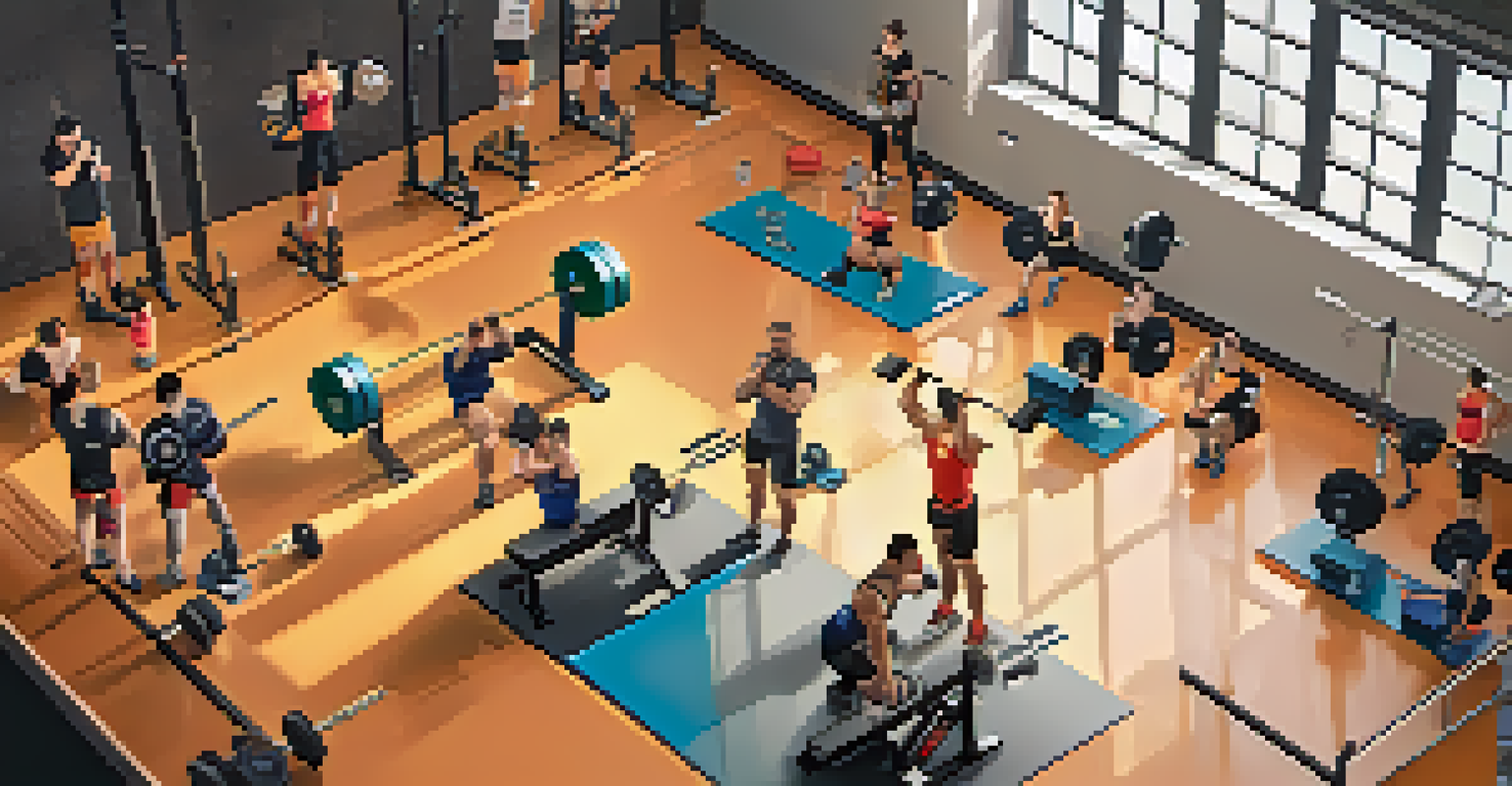The Impact of Wearable Tech on Powerlifting Performance Gains

Understanding Wearable Tech in Powerlifting
Wearable technology refers to devices that can be worn on the body, often collecting data about physical activity. In powerlifting, these gadgets can range from smartwatches to specialized fitness trackers designed for strength training. They help athletes monitor their performance in real-time, making it easier to identify areas for improvement.
Wearable technology is not just about tracking data; it's about providing insights that empower athletes to enhance their performance.
For many lifters, understanding their body’s metrics is key to making progress. Wearable tech allows athletes to track essential data such as heart rate, rep counts, and even muscle engagement during lifts. This data serves as a valuable tool for refining technique and optimizing workout routines.
As the powerlifting community continues to embrace technology, the integration of wearables is becoming more common. This shift not only enhances individual performance but also fosters a culture of data-driven training, where lifters can learn from each other’s metrics and experiences.
How Wearable Tech Measures Performance
Wearable devices have advanced capabilities that allow them to measure various aspects of physical performance. For instance, many trackers can assess lift speed and power output, providing insights into the effectiveness of each rep. This kind of data is invaluable for powerlifters looking to maximize their gains.

Another crucial metric is the monitoring of fatigue levels. By analyzing heart rate variability and recovery times, athletes can determine when they are ready for their next workout. This helps prevent overtraining and ensures that lifters are performing at their best when it matters most.
Wearables Enhance Performance Tracking
Wearable technology helps powerlifters monitor key metrics like heart rate and lift speed, enabling real-time performance analysis.
Moreover, some wearables offer feedback on lifting form, which is essential for avoiding injuries. By providing real-time coaching tips, these devices help lifters maintain proper technique, leading to better performance outcomes and safer workouts.
Setting Goals with Wearable Technology
One of the most significant advantages of wearable tech is its ability to help athletes set and track goals. With data at their fingertips, powerlifters can create specific, measurable, attainable, relevant, and time-bound (SMART) goals tailored to their needs. This structured approach to goal-setting increases motivation and accountability.
The future of training is data-driven, and wearable tech is paving the way for athletes to reach their full potential.
For example, a lifter might set a goal to increase their squat by 10 pounds within a month. By using wearables to track their progress weekly, they can adjust their training regimen as needed, ensuring they stay on track. This adaptability is crucial in a sport where every lift counts.
Additionally, wearables often come with companion apps that provide visual data representations, making it easier to see progress over time. These insights not only boost confidence but also help athletes celebrate small wins along the way, reinforcing their commitment to improvement.
The Role of Data Analysis in Training
Data analysis is a game-changer for powerlifters using wearable tech. By collecting and analyzing performance data, lifters can identify trends and patterns in their training. This allows them to make informed decisions about when to push harder or scale back their efforts.
For instance, if an athlete notices a consistent drop in performance during specific lifts, they can investigate potential causes, such as fatigue or inadequate recovery. Armed with this information, they can adjust their training plan accordingly, leading to more effective workouts.
Goal Setting Made Easier
With wearable tech, powerlifters can set and track SMART goals, adapting their training based on precise data.
Furthermore, having access to historical data enables lifters to learn from their past performances. By comparing current metrics with previous results, athletes can develop a deeper understanding of their strengths and weaknesses, allowing for a more personalized training approach.
Community and Competition through Wearables
Wearable technology has also fostered a sense of community among powerlifters. Many devices allow users to share their progress and achievements with friends or the wider fitness community. This social element can be incredibly motivating, encouraging lifters to push their limits.
In addition, some wearables include features for tracking workouts alongside friends, creating a friendly competitive atmosphere. This can spur athletes to lift heavier weights or perform more reps, driving them to achieve greater heights in their training.
Moreover, online challenges and leaderboards facilitated by wearable tech can ignite a spark of competition. Lifters can participate in global challenges, adding an exciting layer to their training regimen and connecting with others who share their passion for powerlifting.
Injury Prevention with Wearable Tech
Injury prevention is a critical aspect of any strength training program, and wearable technology plays a vital role in this area. Many devices are equipped with sensors that monitor biomechanics, helping lifters maintain proper form and avoid common injuries. This feature can be especially beneficial for beginners who are still mastering their technique.
By providing real-time feedback on lifting mechanics, wearables can alert athletes when they are at risk of injury due to poor form. For instance, if a lifter's back begins to round during a deadlift, the device can prompt them to adjust their posture before it's too late.
Community and Competition Boosts Motivation
Wearables foster a sense of community among lifters, encouraging friendly competition and shared achievements to enhance motivation.
Additionally, wearables can track recovery metrics, such as sleep quality and muscle soreness. This information helps athletes understand their bodies better and make informed decisions about rest days and recovery strategies, ultimately leading to safer and more effective training.
The Future of Wearable Tech in Powerlifting
As technology continues to evolve, the future of wearable tech in powerlifting looks promising. Innovations, such as advanced biometric sensors and artificial intelligence, are expected to enhance the accuracy and functionality of these devices. This could lead to even more personalized training experiences for athletes.
Imagine a future where wearables can predict performance trends based on real-time data analysis, allowing lifters to optimize their training plans automatically. This level of customization could revolutionize the way powerlifters approach their workouts, making them more efficient and effective.

Ultimately, as more athletes embrace wearable technology, we can expect to see the sport of powerlifting evolve. With data-driven insights and enhanced performance tracking, lifters will be better equipped to reach their goals, pushing the boundaries of what is possible in the sport.